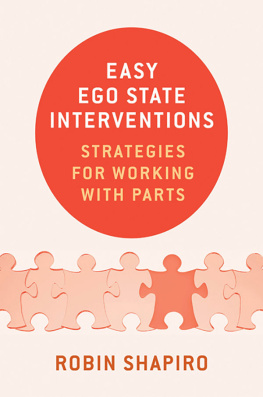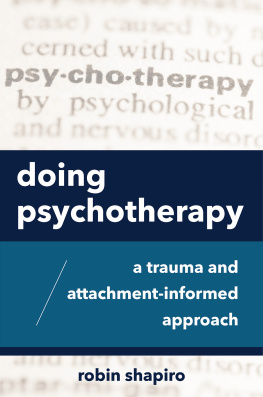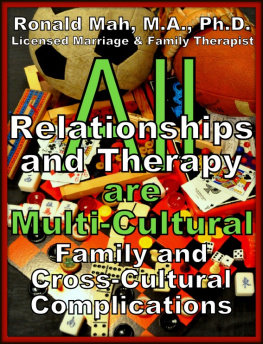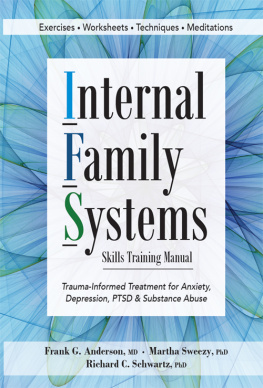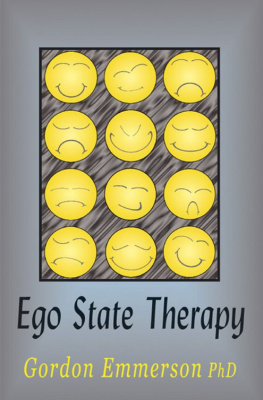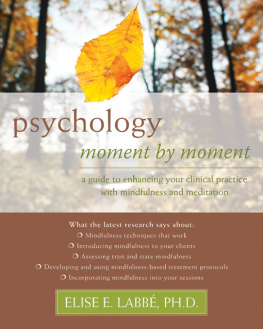Robin Shapiro - Easy Ego State Interventions: Strategies for Working With Parts
Here you can read online Robin Shapiro - Easy Ego State Interventions: Strategies for Working With Parts full text of the book (entire story) in english for free. Download pdf and epub, get meaning, cover and reviews about this ebook. year: 2016, publisher: W. W. Norton & Company, genre: Home and family. Description of the work, (preface) as well as reviews are available. Best literature library LitArk.com created for fans of good reading and offers a wide selection of genres:
Romance novel
Science fiction
Adventure
Detective
Science
History
Home and family
Prose
Art
Politics
Computer
Non-fiction
Religion
Business
Children
Humor
Choose a favorite category and find really read worthwhile books. Enjoy immersion in the world of imagination, feel the emotions of the characters or learn something new for yourself, make an fascinating discovery.
- Book:Easy Ego State Interventions: Strategies for Working With Parts
- Author:
- Publisher:W. W. Norton & Company
- Genre:
- Year:2016
- Rating:4 / 5
- Favourites:Add to favourites
- Your mark:
Easy Ego State Interventions: Strategies for Working With Parts: summary, description and annotation
We offer to read an annotation, description, summary or preface (depends on what the author of the book "Easy Ego State Interventions: Strategies for Working With Parts" wrote himself). If you haven't found the necessary information about the book — write in the comments, we will try to find it.
Quick, essential techniques to practice ego state therapy, a popular therapeutic approach.
Most of us have different aspects, parts, or ego states of ourselvesthe silly and imaginative five-year-old part, for example, or the depressed, anxious, or angry adolescentwhich manifest as particular moods, behaviors, and reactions depending on the demands of our external and internal environments. Ego state therapy refers to a powerful, flexible therapy that helps clients integrate and reconcile these distinct aspects of themselves.This book offers a grab bag of ego state interventionssimple, practical techniques for a range of client issuesthat any therapist can incorporate in his or her practice. In her characteristic wise, compassionate, and user-friendly writing style, Robin Shapiro explains what ego states are, how to access them in clients, and how to use them for a variety of treatment issues. After covering foundational interventions for accessing positive adult states, creating internal caregivers, and working with infant and child states in Part I: Getting Started With Ego State Work, Shapiro walks readers step-by-step through a variety of specific interventions for specific problems, each ready for immediate application with clients. Part II: Problem-Specific Interventions includes chapters devoted to working with trauma, relationship challenges, personality disorders, suicidal ideation, and more.
Ego state work blends easily, and often seamlessly, with most other modalities. The powerful techniques and interventions in this book can be used alone or combined with other therapies. They are suitable for garden-variety clients with normal developmental issues like self-care challenges, depression, grief, anxiety, and differentiation from families and peer groups. Many of the interventions included in this book are also effective with clients across the dissociation spectrumdissociation is a condition particularly well suited to ego state workincluding clients who suffer trauma and complex trauma. Rich with case examples, this book is both a pragmatic introduction for clinicians who have never before utilized parts work and a trove of proven interventions for experienced hands to add to their therapeutic toolbox. Welcome to a powerful, flexible resource to help even the most difficult clients build a sense of themselves as adult, loveable, worthwhile, and competent.
Robin Shapiro: author's other books
Who wrote Easy Ego State Interventions: Strategies for Working With Parts? Find out the surname, the name of the author of the book and a list of all author's works by series.

